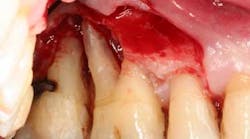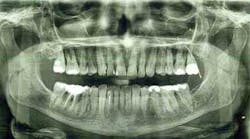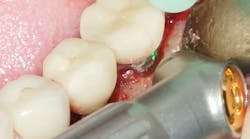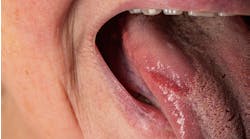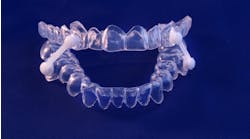I met Dr. Scott Froum 15 years ago. I was adamant about saving as many teeth as I could with periodontal treatment, despite being told by multiple dentists and periodontists that dental implants were my only option.
More on this subject … Saving teeth: They must not teach that as the first therapeutic response in dental school
We saved three out of four molar areas (which have been functioning for 15 years now). The lost area is at teeth nos. 2 and 3. I remembered later that they had been damaged in an earlier dental matter. Tooth no. 2 was very loose, and no. 3 had a big crack in it.
After these teeth were removed, I tried getting a dental implant to replace no. 3, but for whatever reason, I was not comfortable, so we abandoned that treatment. I am now edentulous in that area, and I was advised to eat on the other side. Thus, our adventure began.
Difficulty chewing
Eating “on the other side” is easily enough said, but eating is also automatic. The tongue moves food around the mouth without our help, and the mouth decides to swallow on its own. When we (I) have only one side that can chew, incompletely chewed/masticated food can go down, but it can be too big for the alimentary passages and can get into the lungs, leading to coughing spasms. Without teeth or dental implants (especially the teeth responsible for most of the chewing), the food can be too big to swallow. My difficulty chewing led to difficulty swallowing and food aspiration.
Dysphagia: Difficulty swallowing
One of the less obvious repercussions of not having teeth is difficulty swallowing. In my case, osteophytes (bone spurs) on my C2 and C3 vertebrae developed (causation unknown), and full epiglottis closure was problematic. I had to develop coping mechanisms to help me swallow my food that was not completely chewed. In addition, I saw a speech pathologist who helped me train my throat muscles and advised me of mindful eating techniques, such as frequent hydration while eating, eating soft foods, slow eating, having small portions, and cutting food into small pieces.
Food aspiration
Trouble chewing and swallowing can lead to coughing spasms, and these coughing spasms can be pretty scary and people can die. I learned there are two stages of food aspiration: the first is penetration (not into the lung), and the second is aspiration proper (into the lung). Working with my therapist taught me that I cannot make eating automatic; I have to concentrate when I eat. I trained my throat muscles and strengthened them through various exercises1 that basically aim to expel food upward that goes down the wrong passage. Frequent coughing while eating is encouraged.
I have two sets of exercises, each taking a few minutes. I set my telephone alarm to beep at me at 11 a.m. and 2 p.m. These exercises can be done anywhere. I can do them while I’m on the subway or even on the platform while I wait. The training regimen says to do these exercises daily for a few weeks, and then every second day is enough, but I try for more often.
The chart of swallowing exercises from the National Foundation of Swallowing Disorders is used with permission.
Editor’s note: This article originally appeared in Perio-Implant Advisory, a chairside resource for dentists and hygienists that focuses on periodontal- and implant-related issues. Read more articles and subscribe to the newsletter.
Reference
- Swallowing exercises. National Foundation of Swallowing Disorders. https://swallowingdisorderfoundation.com/oral-swallowing-exercises/
Martin Heilweil, PhD, has a PhD in social psychology from the University of Michigan. His proprietary work includes financial analyses, litigation support, financial outcome research evaluation for land use litigation matters, and statistical and data management (clinical trials) for pharmaceutical new drug applications for FDA approval. He has provided litigation support in technology and database review through written and oral presentations to judicial/administrative law forums, litigation management, witness preparation, Westlaw specialization, and jury consultant (defense) in one white-collar criminal prosecution.

